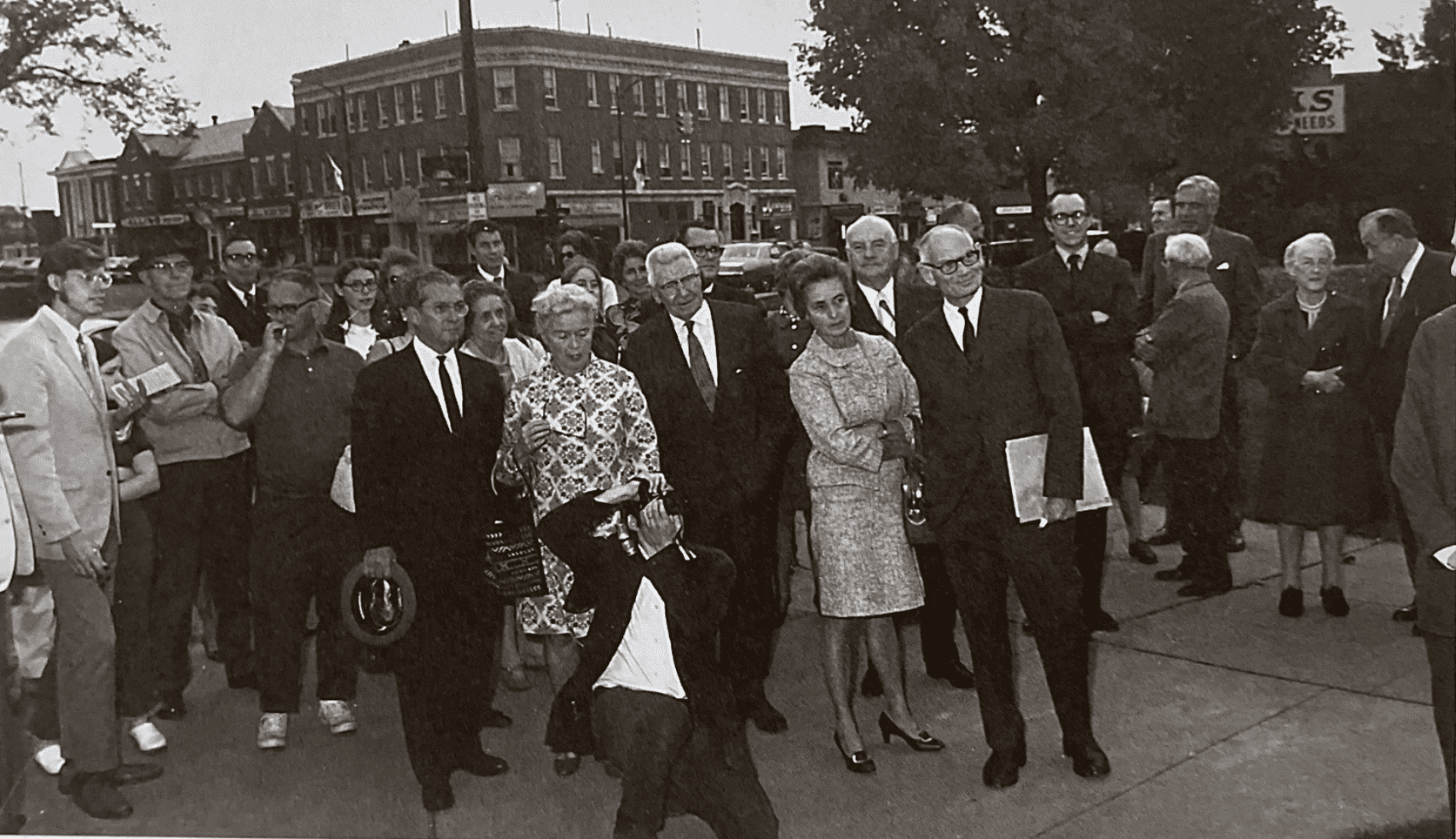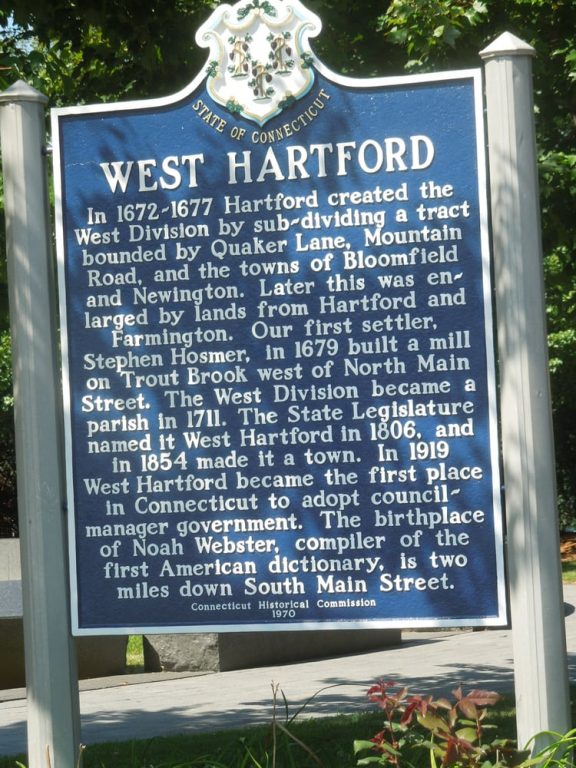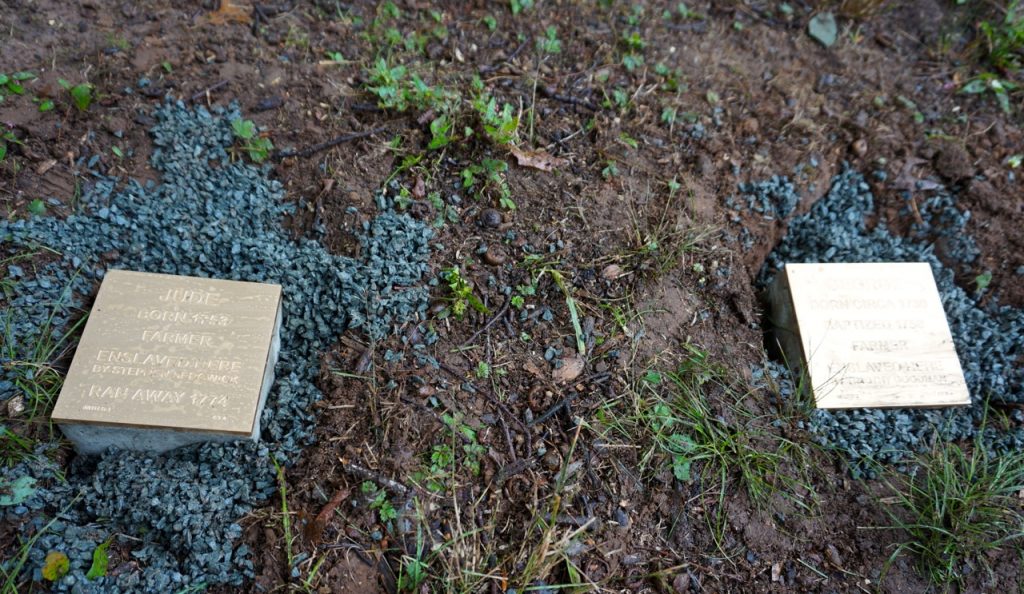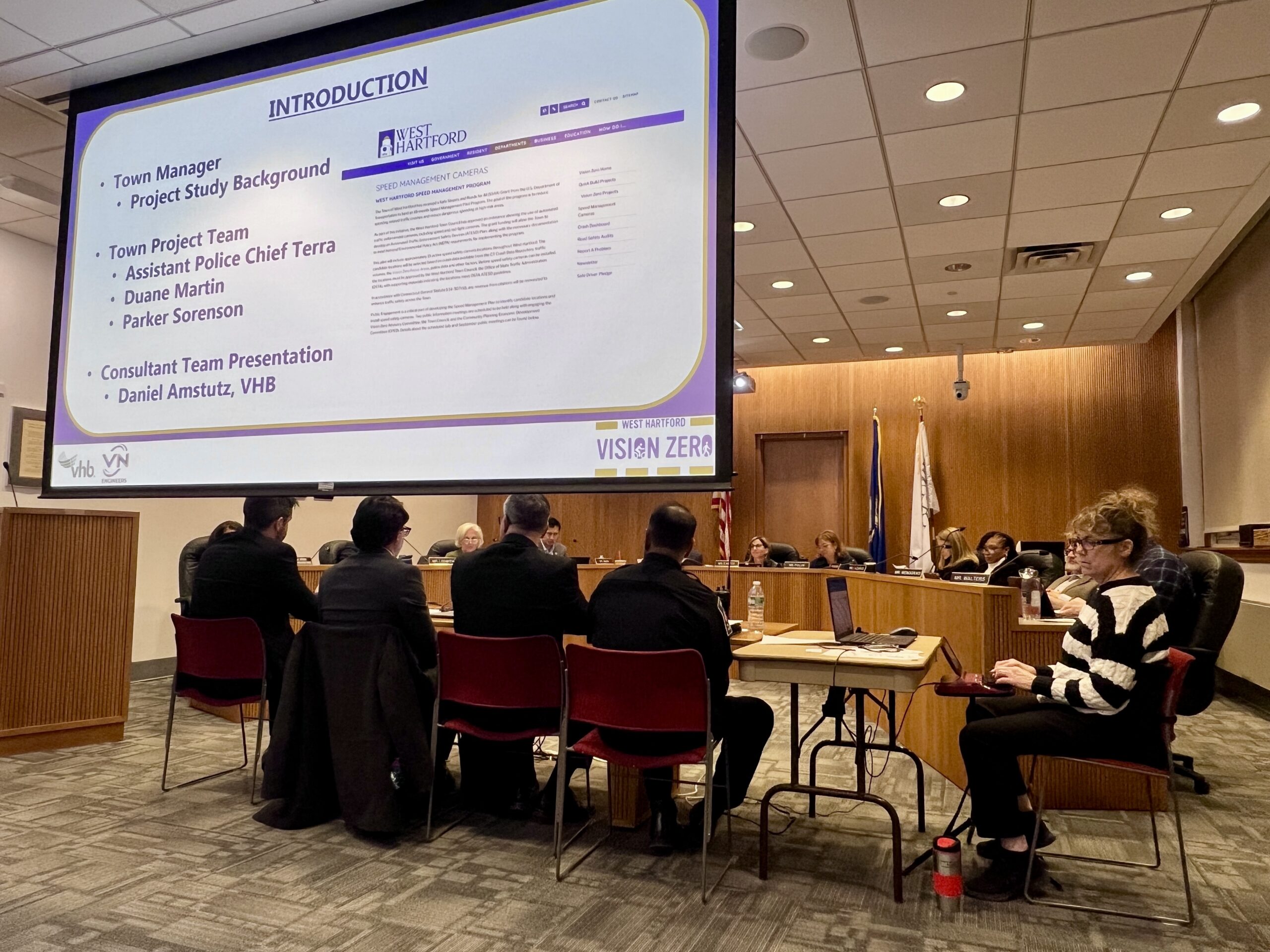From the West Hartford Archives: Historical Marker Dedication

Audio By Carbonatix

Presentation of historical marker in West Hartford, Oct. 12, 1970. Courtesy of Noah Webster House & West Hartford Historical Society
Historian Jeff Murray takes a look into West Hartford’s past to uncover some surprising information, stir up some memories, or reflect on how much life has changed – or hasn’t changed at all. Enjoy this week’s ‘From West Hartford’s Archives’ …
By Jeff Murray
On Oct. 12, 1970, the Connecticut Historical Commission presented the Town of West Hartford with a historical marker installed on the grounds of the Veterans Memorial in the Center. Located at the northwest corner of Farmington Avenue and North Main Street, the ceremony dedicated the marker to the founding of the town in the 1670s and its subsequent development.
The West Hartford Historical Society was chartered in 1953 to discover and preserve historic materials, as well as to prevent the destruction of historic sites (it was admirable, but there was absolutely nothing stopping the bulldozers in the coming years). Some of the first lectures given in the mid-1950s were by old West Hartford residents. Blanche Darling, who had grown up in town in the 1890s, spoke on “Life on a Farm in Early West Hartford.” Louise Day Duffy, a former teacher, Board of Education member, and inspiration behind Duffy Elementary School, spoke on “Recollections and Memories of an Historical House in West Hartford.” No doubt the surge in energy behind the historical society movement was driven by the 1954 centennial and postwar prosperity.
Meanwhile, in 1962, the historic Noah Webster House was given to the town by owner Alice Hamilton and designated a National Historic Landmark. It was in poor condition though: warped floors, peeling paint, and rotted windowsills. Efforts to fundraise for restoration came to a head in 1964 and the Town Council voted to appropriate $8,500 for repairs in January 1965. The Noah Webster House Restoration Committee received approval to form a foundation to raise funds for remodeling the house and establishing it as a museum open to the public.
The movement to broaden the scope of historical preservation beyond individual owners was taking place in the background too. President Lyndon Johnson’s Great Society programs in the mid-1960s folded historic preservation into a wider cultural policy.
The National Historic Preservation Act was signed into law in 1966. It established the National Register of Historic Places and laid the groundwork for states to begin surveying, designating, and marking sites more systematically. That same year, Congress established the American Revolution Bicentennial Commission in preparation for the 1976 bicentennial.
From 1967 to 1969, states formed their own commissions and encouraged communities to “prepare” by identifying historic sites from the colonial and revolutionary period. Towns like West Hartford looked to secure recognition. Throughout the 1960s, many state historical commissions, like Connecticut’s, were standardizing marker designs, expanding from war commemorations to industrial, cultural, and social history sites, and using markers as public evidence of preservation work for legislators and funders.

Historical Marker noting the founding of West Hartford on Veterans Memorial Green. Courtesy of Tracey Wilson (we-ha.com file photo)
In other words, the 1970 dedication did not happen in a vacuum; it was one of the results of a decade of accelerating historical recognition work, rising public interest in public displays of history, and site identification in anticipation of 1976.
This all came together in the summer of 1970 when then-West Hartford Mayor Ellsworth S. Grant requested that the Connecticut Historical Commission dedicate a historical marker in the Center. Similar markers were being given to all Connecticut towns upon request, according to William Morris, the director of the commission. The text of the inscription was written by Nelson Burr, one of the most prominent historians in our town.
On Oct. 12, 1970, the historical marker was unveiled on the grounds of the former Town Hall, organized and conducted by the West Hartford Historical Society. The dedication ceremony featured many drivers of this local and regional movement. Burr was a member of the West Hartford Historical Society executive committee. Gordon Bennett, the president of the Noah Webster House Foundation, which had restored the historic house and opened the museum just a few years before, participated in the unveiling. Mayor Grant (who was president of the Historical Society at the time), Town Manager Richard Custer, State Sen. Jay Jackson, Superintendent of Schools Charles Richter, and Connecticut Historical Commission chairman Erich Hatch attended the ceremonies. Also in attendance (and seen in the featured photograph) was Marion Hepburn Grant, a Hartford historian and the daughter of feminist Katharine Houghton Hepburn.
After the unveiling, the historical society met at the West Hartford Public Library to hear a talk by the director of the Connecticut Historical Commission on his opposition to the “continual destruction of priceless historic sites.” Just a month later, a meeting was held in the public library to vote on a merger between the Noah Webster House Foundation and the West Hartford Historical Society. The two sides voted to join forces and make it official in November 1970, linking the two organizations by name and by location.
The doors of the museum were thrown open for cider and doughnuts. The house was decorated for the holiday season and featured several pieces of furniture and antique displays.
The U.S. Bicentennial in 1976 fueled a massive wave of site restorations and historical recognition. Over the years, greater attention has been given to the smaller houses, industrial heritage, and sites important to underrepresented groups.
In 2018, the Witness Stones project came to West Hartford through the work of students in Sean O’Connor’s A.P. U.S. History class in conjunction with retired history teachers Liz Devine and Tracey Wilson, who was town historian at the time. Using resources from the Noah Webster House & West Hartford Historical Society and the Webster Library at the First Church, two brass plaques were installed in the Old Center Cemetery in the fall of 2018 to commemorate the lives of those who were enslaved in our town and left only few details of their lives.

The first Witness Stones were placed next to Bristow’s headstone in Old Center Cemetery on North Main Street in 2018. Photo credit: Ronni Newton (we-ha.com file photo)
Historical markers come in all shapes and sizes. Our institutions provide the scaffolding for remembering the people who came before us, regardless of status. The movement to preserve our history gained steam in the 1960s with governmental backing and much of the work that has been done can be traced back to this early period.
It is quite poetic that this photo of the 1970 dedication came from the archives of the Noah Webster House & West Hartford Historical Society.
Jeff Murray was born and raised in West Hartford and has been involved with the Noah Webster House & West Hartford Historical Society since 2011 when he was a high school student and won the Meyer Prize for his essay on local history. Jeff routinely volunteers as local history researcher uncovering information for numerous museum programs such as the West Hartford House Tour and West Hartford Hauntings. Jeff works as a data analyst at Pratt & Whitney.
Like what you see here? Click here to subscribe to We-Ha’s newsletter so you’ll always be in the know about what’s happening in West Hartford! Click the blue button below to become a supporter of We-Ha.com and our efforts to continue producing quality journalism.



